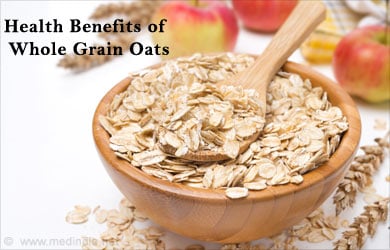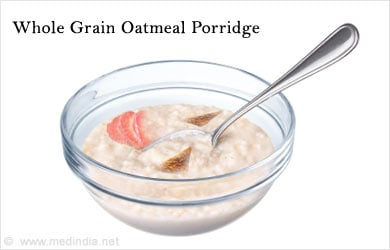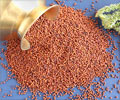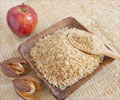- Guo L, Tong LT, Liu L, Zhong K, Qiu J, Zhou S. The cholesterol-lowering effects of oat varieties based on their difference in the composition of proteins and lipids. Lipids Health Dis. 2014 Dec 5;13(1):182. [Epub ahead of print] PubMed PMID: 25477248.
- Meydani M. Potential health benefits of avenanthramides of oats. Nutr Rev. 2009 Dec;67(12):731-5. doi: 10.1111/j.1753-4887.2009.00256.x. Review. PubMed PMID: 19941618.
- Maki KC, Galant R, Samuel P, Tesser J, Witchger MS, Ribaya-Mercado JD, Blumberg JB, Geohas J. Effects of consuming foods containing oat beta-glucan on blood pressure, carbohydrate metabolism and biomarkers of oxidative stress in men and women with elevated blood pressure. Eur J Clin Nutr. 2007 Jun;61(6):786-95. Epub 2006 Dec 6. PubMed PMID: 17151592.
- Boffetta P, Thies F, Kris-Etherton P. Epidemiological studies of oats consumption and risk of cancer and overall mortality. Br J Nutr. 2014 Oct;112 Suppl 2:S14-8. doi: 10.1017/S0007114514002268. PubMed PMID: 25267240.
What are Whole Grains?
The Romans once regarded oats as a coarse food, only suitable for barbarians and they used it primarily as food for their livestock. It was the Romans however, who introduced the grain to Britain, where it soon became the primary cereal. The world has changed a lot since the days of the Roman Empire and oats have today come to be regarded as the breakfast of champions! After wheat and rice, oats is probably the most widely-consumed form of grain and it is one of the most popular of all breakfast cereals. Whole grain oats are also highly recommended by dieticians and nutritionists because of their low calorie density and high nutrition value.

Whole grains are frequently marketed as health foods, along with organic produce and most of us simply know that whole grains are supposed to be healthier, as compared to the refined and processed varieties. While this is true, it would help us to better understand what whole grains are. A whole grain is basically a cereal grain that includes the germ, endosperm and bran, which makes it a lot higher in nutritional value and fiber content. Whole grains come in different varieties such as intact, ground, cracked or flaked kernels.
Most people don’t just consume oats for its culinary value, but for its health benefits, so it is advisable to again stick to the whole grain varieties. The intact whole grain form of oats is not widely sold as is, but there are other whole grain varieties available like steel-cut oats. Whole grain oats are referred to as groats. Steel-cut oats are unprocessed and are quite simply chopped groats. They take longer to cook, as compared to instant oats, but they contain the most nutritional value and have a nutty flavor.
Whole Grain Oats Nutrition Facts
Whole grain oat cereal may be best known as a fiber rich food but it does contain many other nutrients.
What are the Health Benefits of Whole Grains?
Whole grains are highly recommended because of their nutritional value and because they do not contain empty calories, as is the case with most processed and refined foods. Whole grains have a high fiber content, which not only aids digestion but a high fiber intake is also associated with a reduced risk of heart diseases, diabetes and cancer. As an added benefit, whole grains can also help you lose those extra pounds and get in shape. Whole grains can be quite heavy and will keep you satiated for a lot longer, thereby reducing your risk of overeating or snacking on junk foods.
Whole oats offer all of the benefits of other whole grains and a lot more:
Provide cholesterol-lowering effect – Beta-glucan, a type of soluble fiber, is found in oats and it helps lower cholesterol. It works by facilitating bile acid excretion and along with it any serum cholesterol that’s bound to the bile. Because of its purported effects in reducing LDL, oats may offer protection against conditions like atherosclerosis.
Offer increased protection against LDL damage – Research has also found that avenanthramides, an antioxidant present primarily in oats, exerts an anti-inflammatory effect and could protect the blood vessels from the damage of LDL cholesterol.
Reduce risk of diabetes – The American Diabetes Association advises diabetics to consume whole grains like oats, as studies suggest that the consumption of oatmeal may lower the risk of type 2 diabetes. This benefit is again attributed to the high content of soluble fiber, which helps regulate blood glucose levels.
Control high blood pressure – Recent studies suggest that oatmeal could help lower high blood pressure, a benefit that is again linked to the soluble fiber content in oats.
Provide possible protection from cancer – A few studies indicate that the consumption of oatmeal may offer marginal protection against the risk of chronic diseases and cancer, but research this far has been inadequate.

Whole Grain Oats Recipes
To derive some of the benefits of whole grain oats, try and introduce oats into your cooking. Whole grain oats can be used as an ingredient in numerous recipes and in different forms. You can use it as a thickener in dishes like meatloaf and certain pies or you could even grind it in a food processor and use it as a healthy alternative to breadcrumbs.
Some other interesting ways to use oats include:
- You can use it to make a topping for a bake, combining it with brown sugar and a low-fat spread. You can even throw in some sliced almonds.
- You can also add whole grain rolled oats to smoothies and milkshakes for some added nutrition and a nutty flavor.
- The traditional oatmeal porridge can get a bit monotonous, so instead of simply cooking some whole oats, add a bit of cinnamon and some dried apple pieces to the porridge while cooking.

However it is important to keep in mind that whole grain oats are not gluten-free but they do not contain the same type of gluten that poses a risk to people with celiac disease and gluten sensitivity. This said, it’s important to restrict your intake of oats if you suffer from celiac disease and you should avoid it altogether if you are highly reactive to gluten.







